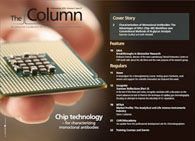Solar power
Researchers at NASA?s Marshall Space Flight Centre in Huntsville, Alabama, USA, are using their Solar Thermal Test Facility to expose a unique mass spectrometer to the extreme conditions that it will face on a mission to Mercury.

Researchers at NASA’s Marshall Space Flight Centre in Huntsville, Alabama, USA, are using their Solar Thermal Test Facility to expose a unique mass spectrometer to the extreme conditions that it will face on a mission to Mercury.
Strofio is a mass spectrometer that will form part of the SERENA instrument package to analyse the planet Mercury’s surface and gain new insight into its geological history. When Strofio reaches Mercury, the Sun will expose it to 14 700 watts per square metre of solar energy, reaching temperatures of 120 ˚C on the sunny side and the freezing temperatures of space on the other.
To test the thermal balance of the device before launch, researchers will simulate this mix of temperatures using the Solar Thermal Test Facility’s two-story tall curved mirror. The mirror is made of 144 smaller segments and is capable of generating 1 000 000 watts per square metre of solar energy intensity at its focal point. For the conditions Strofio will face, the facility will only need to partially uncover 26 segments. The light will then be focused onto a small vacuum chamber, which contains a liquid nitrogen shroud that mimics the freezing temperatures of deep space.
Once testing is complete the mass spectrometer will fly on board ESA’s 2014 Mercury Planetary Orbiter mission.
This story originally appeared in The Column. Click here to view that issue.

Best of the Week: Food Analysis, Chemical Migration in Plastic Bottles, STEM Researcher of the Year
December 20th 2024Top articles published this week include the launch of our “From Lab to Table” content series, a Q&A interview about using liquid chromatography–high-resolution mass spectrometry (LC–HRMS) to assess chemical hazards in plastic bottles, and a piece recognizing Brett Paull for being named Tasmanian STEM Researcher of the Year.
Using LC-MS/MS to Measure Testosterone in Dried Blood Spots
December 19th 2024Testosterone measurements are typically performed using serum or plasma, but this presents several logistical challenges, especially for sample collection, storage, and transport. In a recently published article, Yehudah Gruenstein of the University of Miami explored key insights gained from dried blood spot assay validation for testosterone measurement.
Determination of Pharmaceuticals by Capillary HPLC-MS/MS (Dec 2024)
December 19th 2024This application note demonstrates the use of a compact portable capillary liquid chromatograph, the Axcend Focus LC, coupled to an Agilent Ultivo triple quadrupole mass spectrometer for quantitative analysis of pharmaceutical drugs in model aqueous samples.